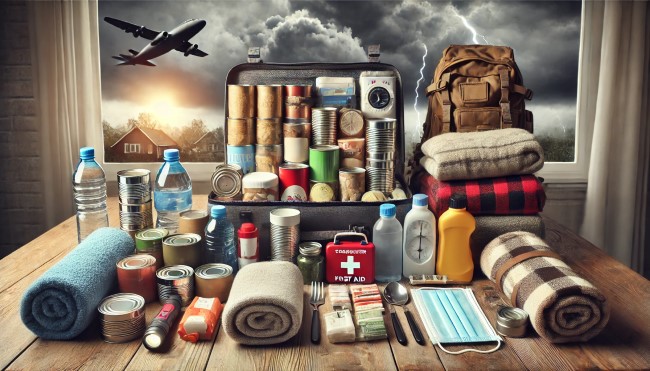Building a Disaster Preparedness Kit: Essential Supplies

Having a well-stocked disaster preparedness kit can make all the difference in unexpected emergencies like natural disasters, power outages, or evacuation situations. Being prepared can save lives and reduce stress in critical situations, from hurricanes to earthquakes to winter storms and power failures.
This guide will help you understand what essential supplies to include in your kit, why each item is important, and how to ensure your kit is up-to-date, especially regarding first aid supplies.
Basic Survival Items
At the core of any disaster preparedness kit are the supplies necessary to survive for at least 72 hours, as recommended by the Federal Emergency Management Agency (FEMA). Let’s break down the most crucial components.
Food and water
Access to clean water and food is critical in an emergency. Non-perishable food items like canned goods, protein bars, dried fruits, and instant meals should be included. Stocking enough food to last each person in your household for three days is essential.
- Water: Aim for at least one gallon of water per person per day for drinking and basic hygiene needs. Portable water filters or purification tablets are also great backups if clean water isn’t readily available.
- Food: Non-perishable items like canned tuna, beans, and freeze-dried meals are excellent choices. Don’t forget a manual can opener!
Flashlights, batteries, and backup power
Disasters often come with power outages, making flashlights and batteries critical for dark navigation. Backup power sources, like portable phone chargers or power banks, can help keep essential devices operational. In more extended emergencies, solar-powered chargers can be a reliable energy source.
Emergency tools
A multi-tool can be incredibly helpful for various tasks, including cutting, repairing, or even opening canned goods. Keep duct tape on hand for temporary repairs and sealing leaks, while plastic sheeting can create makeshift shelters or protect from rain.
First Aid Essentials
The first aid kit is one of the most important components of any disaster preparedness kit. Medical assistance may not be immediately available in an emergency, so having supplies to treat injuries or illnesses is essential.
Key first aid supplies
A well-stocked first aid kit should include:
- Bandages and sterile gauze for treating cuts and wounds.
- Antiseptics like hydrogen peroxide or alcohol wipes for disinfecting.
- Pain relievers such as ibuprofen or acetaminophen.
- Tweezers, scissors, and medical tape for more specific injuries.
Keeping first aid supplies up-to-date
It’s essential to regularly review your first aid kit for expired items, particularly medications that may no longer be safe to use. Always check for any recalled medications or expired supplies that could be harmful. In recent years, some well-known medications like Zantac were ordered off the market due to their potential cancer-causing properties, so make sure your kit is stocked with safe and up-to-date medication.
Shelter and Warmth
In a disaster, you may need to shelter in place or endure extreme weather conditions. Having the right materials to stay warm and dry is vital for survival.
Blankets and sleeping bags
Ensure that your disaster kit includes warm blankets or sleeping bags, particularly if you live in an area prone to cold weather. Consider investing in emergency blankets (thermal or space blankets), which are compact, lightweight, and highly effective at conserving body heat.
Protective clothing
You may need protective clothing for extreme weather, such as waterproof jackets, gloves, and hats. These items can protect you from harsh conditions like rain, snow, or intense sun exposure.
Personal Hygiene and Sanitation
Maintaining hygiene during an emergency can be challenging, but avoiding infections and maintaining a sense of normalcy is crucial.
Hygiene items
Your kit should contain soap, hand sanitizer, and moist towelettes for basic hygiene. It should also include toothbrushes, toothpaste, and deodorant to maintain personal cleanliness, especially if evacuation or shelter-in-place lasts several days.
Sanitation supplies
Waste disposal can become a significant issue in disaster situations. Stock trash bags and portable toilet supplies, such as collapsible toilets or biodegradable bags, to handle sanitation needs without running water or plumbing.
Communication and Navigation Tools
Staying informed and connected during a disaster is crucial, particularly if local services are disrupted.
Battery-powered radio
A battery-powered radio can help you stay informed about emergency updates, weather alerts, and evacuation notices. Choose a model with NOAA (National Oceanic and Atmospheric Administration) alerts for the most up-to-date information.
Phone chargers and maps
Ensure you have extra phone chargers or power banks to keep your mobile devices functional. In the event of electronic failures or GPS outages, a map and compass can help you navigate to safety or find essential resources.
Important Documents and Cash
In addition to supplies, it’s important to protect key documents and finances that you may need during or after a disaster.
Identification and emergency contacts
Keep copies of identification documents, insurance policies, and emergency contact information in a waterproof pouch. This ensures you have access to vital information in the event of loss or displacement.
Emergency cash
ATMs and card systems may be down during emergencies, making cash essential. Store small bills in your disaster kit for purchasing supplies if electronic transactions aren’t possible.
Conclusion
Building a comprehensive disaster preparedness kit is essential in safeguarding your family’s safety during emergencies. By including food, water, first aid supplies, and the necessary tools for survival, you can be better prepared for the unexpected. Remember, a well-prepared disaster kit can make all the difference when disaster strikes—providing peace of mind and increasing your chances of survival.



